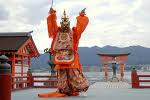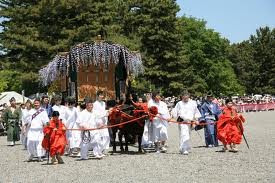Sanki Daigongen 三鬼大権現 . see below
:::::::::::::::::::::::::::::::::::::::::::::::::::::::::::::::::::::::::::::::::::::::::::::::::::
Itsukushima Shrine (Itsukushima Jinja)
***** Location: Miyajima, Japan
***** Season: Various, see below
***** Category: Observance
*****************************
Explanation

厳島神社
quote
A Shinto shrine on the island of Itsukushima (popularly known as Miyajima 宮島) in the city of Hatsukaichi in Hiroshima Prefecture in Japan.
The shrine complex is listed as a UNESCO World Heritage Site.
The shrine is dedicated to the three daughters of Susano-o no Mikoto, Shinto deity of seas and storms and brother of the great sun deity, Amaterasu (tutelary deity of the Imperial Household). Because the island itself has been considered sacred, in order to maintain its purity commoners were not allowed to set foot on Miyajima through much of its history. In order to allow pilgrims to approach, the shrine was built like a pier over the water, so that it appeared to float, separate from the land, and therefore existed in a liminal state between the sacred and the profane.
 The shrine's signature red entrance gate, or torii, was built over the water for much the same reason. Commoners had to steer their boats through the torii before approaching the shrine.
The shrine's signature red entrance gate, or torii, was built over the water for much the same reason. Commoners had to steer their boats through the torii before approaching the shrine.The first shrine buildings were probably erected in the 6th century, and the shrine has been destroyed many times, often by typhoons.
In 1168, Taira no Kiyomori 平清盛 had it rebuild.
© More in the WIKIPEDIA !
I visited many times, is is truely an amazing place.
The reflections of the shrine in the water on a bright evening or moonlit night are superb.
There are many shrines of this name in other parts of Japan.

source : facebook - Japan Dream
:::::::::::::::::::::::::::::::::::::::::::::::::::::::::::::::::::::::::::::::::::::::::::::::::::
. The White Shrine Horse at Miyajima 宮島白馬
:::::::::::::::::::::::::::::::::::::::::::::::::::::::::::::::::::::::::::::::::::::::::::::::::::
kigo for the New Year
Itsukushima jinja no toshikoshi sai 厳島神社の年越祭
(いつくしまじんじゃのとしこしさい)
Crossing into the new year at Itsukushima shrine
January 6
One of the three great ceremonies at the shrine.

People involved in farming come to the shine to pray for a good harvest.
Ritual dance performance and later a feast and talks about farmwork and crop prices held.
.................................................................................
Itsukushima no on yumi hajime
厳島の御弓始 (いつくしまのおんゆみはじめ)
first shooting with bow and arrow at Itsukushima
kisha 鬼射(きしゃ)"hitting the demon"
onyumi shinji 御弓神事(おんゆみしんじ)
honorable ceremony of the bow
On January 20

The target with the character 鬼, called the "demon target" 鬼的 and shot at with bow and arrow to prevent evil for the coming year.
Now held at the shrine Oomoto Jinja at Miyajima
宮島の大元神社 Omoto shrine ceremony
Oomotesai 大元祭.
.................................................................................
Itsukushima Shrine New Year Ceremonies
Jan 1
御神衣献上式 Go Shin-i Kenjo-shiki Ceremony (offering new clothes to deities)
歳旦祭 Saitan-sai Festival Ceremony starts at noon. Bugaku traditional dance performance starts at 5:30am.
Jan 2
二日祭り Futsukasai Ceremony 09:00 Bugaku performance 13:00
Jan 3
元始祭 Genshisai Ceremony 09:00 Bugaku performance 13:00
Jan 5
地久祭 (Chikyuusai) Chikyusai Ceremony and Bugaku performance 05:30 Includes Batoh (Sunrise Dance) only performed once a year on this day.
source : eventful.com/events

source : fb
cap for bugaku dance
:::::::::::::::::::::::::::::::::::::::::::::::::::::::::::::::::::::::::::::::::::::::::::::::::::
kigo for late summer
Itsukushima matsuri 厳島祭 (いつくしままつり)
Itsukushima festival
Itsukushima kangensai 厳島管絃祭(いつくしまかんげんさい)
17th day of the sixth lunar month.
Now on the 17th day of July.
The main festival of the shrine.

Special gozabune ships are made for the procession toward the gate in the water.
Bugaku dance performance and gagaku tradtional music are part of the festival.
:::::::::::::::::::::::::::::::::::::::::::::::::::::::::::::::::::::::::::::::::::::::::::::::::::
kigo for early autumn
Itsukushima Ennen sai
厳島延年祭(いつくしまえんねんさい)
Ennen Festival at Itsukushima
Ennen "life prolonging" dance performances are held at many shrines in Japan.

tamatori matsuri 玉取祭 (たまとりまつり)
"festival of grabbing the bead"
On the 14th day of the seventh lunar month, now in mid-August on a Sunday of high tide.
On a boat in front of the main hall is a boat with a large rosary and young men of the island try to grab a bead of about 20 cm diameter for good luck.

clay bell replica of the TAMA bead
:::::::::::::::::::::::::::::::::::::::::::::::::::::::::::::::::::::::::::::::::::::::::::::::::::
kigo for early winter
Itsukushima chinza sai
厳島鎮座祭 (いつくしまちんざさい)
Shrine dedication festival
oshimeshi, o shime shi 御燈消(おしめし)"turning off the lights"
yamaguchi toji no matsuri 山口閉の祭(やまぐちとじのまつり)
"closing down mountain roads" festival
After the shrine is closed down for the winter, it will be re-opened the next year for "openening the mountain road" 山口開. Loggers are not allowed to go to the forest and cut down trees during the closed time.
On the ten days from the first day of the wild boar in the tenth lunar month to the day of the monkey in the eleventh lunar month.
Nowadays on the first day of the monkey in November.
During these 10 days it is not allowed to make a loud noise on the island.
Things that produce lound and high noises are covered with blankets to keep them quiet. The lids of rice cookers had to be closed especially carefully.
On the last day, the day of the monkey, all lanterns and lights on the island are turned off and rituals are carried out in the dark.
.......................................................................

Miyajima in the snow

夏の月 Summer Moon at Miyajima
- reference : Tsuchiya Koitsu 土屋光逸 (1870-1949) -
:::::::::::::::::::::::::::::::::::::::::::::::::::::::::::::::::::::::::::::::::::::::::::::::::::::
quote
Sato Masato writes:
Due to belief in the "Three Female Kami" (sanjoshin) of Munakata at Itsukushima Jinja, the Itsukushima kami was worshipped as a protector of fishermen and boats.
Itsukushima is also known as a "military kami" (gunshin), as seen in this passage from the Ryōjin hishō:
"To the west of the [Ōsaka] checkpoint (seki) is the kami of the battlefield, Ichibon Chūsan (Kibitsu Shrine) and Itsukushima in Aki ..."
After becoming governor of Aki (Aki no kami 安芸守) in 1146, Taira no Kiyomori (1118~1181) often visited the shrine. Upon Kiyomori's recommendation, Goshirakawa-in and Kenshunmon-in visited the shrine in the third month of 1174, and Takakura Jōkō visited twice.
At the end of the Heian Period Itsukushima was worshipped by the entire Heike clan, and in 1168 the shrine's shaden structure was restored and expanded. This connection to the Heike clan may have originated in the trade and shipping in the Inland Sea that had flourished since the days of Taira no Tadamori (Kiyomori's father).
Due to Heike devotion, the Heike Nōkyō scrolls 平家納経 (a National Treasure) were originally donated to the shrine in 1164. In the medieval period Itsukushima was supported by the Ōuchi and Mōri clans, and the Shingon temple Suishōji 水精寺 became the shrine's administrative temple.
Also a legend began that Kūkai founded (kaisan) the temple Misen. The "original Buddhist deity" (honji) of Itsukushima was believed to be the Eleven-faced Kannon (Ekadasamukha Avalokitesvara) or Mahâvairocana.
Among commoners, a cult of Ebisu-gami developed, and Itsukushima was also worshipped by fishermen and merchants.
source : Kokugakuin University. 2006
. Shrine Munakata Taisha 宗像大社 .
Fukuoka
:::::::::::::::::::::::::::::::::::::::::::::::::::::::::::::::::::::::::::::::::::::::::::::::::::::

The Deer are seen as messengers of the deity of Miyajima and roam freely, sometimes as a nuisance for the tourists.
Legend knows that when Mori Motonari and Sue Harukata fought their battle in 1555, Harukata had his troops near the shrine, while Motonari landed on the other side of the island, trying to get over the mountains and through the dense wild forest to make a surprize attack.
His troups almost lost their way in the dark night, but then a deer showed them the small path.
(The deer was MAYBE the priest of the shrine, disguised as a deer, trying to help his friend and sponsor Motonari.)
*****************************
Worldwide use
*****************************
Things found on the way
Miyajima hariko 宮島張子 papermachee dolls

CLICK for more images !
. Regional Folk Toys from Japan .
:::::::::::::::::::::::::::::::::::::::::::::::::::::::::::::::::::::::::::::::::::::::::::::::::::::
. WASHOKU
Anagomeshi あなごめし Rice with eel
Station lunchbox from Miyajima
The great rice paddle shamoji in Miyajima 宮島しゃもじ
The island is also famous for its red maple leaves in autumn.

. momiji manjuu もみじ饅頭
rice dumplings in the form of red maple leaves
:::::::::::::::::::::::::::::::::::::::::::::::::::::::::::::::::::::::::::::::::::::::::::::::::::::
Festivals calendar at Miyajima
Most rituals are accompanied by bugaku dance on the stage above the water.
厳島神社舞楽

. . . . . January
Shin-i Kenjo-shiki Ceremony (offering new clothes to deities)Saitan-sai Festival
Futsukasai
Genshisai
Chikyusai
Momotesai
. . . . . February
Setsubun Festival
Miyajima Oyster Festival
. . . . . March
Memorial Service for Kitchen Knives
Kiyomori Shrine Festival
Miyajima Hina Doll Presentation
. . . . . April
Hiwatari . Walking Over Fire Ceremony
Toukasai
Satsuki Festival
. . . . . May
Memorial Service for Empress Suiko
. . . . . June
Japan's Ancient Martial Arts Performance
Kobo Daishi's Birthday Celebration
Great Benzaiten Festival of Itsukushima
(Daiganji Temple)
. Itsukushima Hime 厳島姫命
as Benten, Benzaiten 弁財天
. . . . . July
Seven Gods of Fortune Festival (Daishoin Temple)
Itsukushima Shrine Kangen Festival
. . . . . August
48,000-day Kannon Festival
Miyajima Floating Fireworks Festival
Kinseki Jizo - son Festival (Tokujuji Temple)
. . . . . September
Tanomosan (small boats filled with dolls and fruit that are set adrift from Itsukushima Shrine to sail toward the Otorii Gate.)
Mantoo-e . candle light memorial
. . . . . October
Akiyo Tomoeda Noh Performance
Kikkasai
Sanno Shrine Festival
Tea Dedication Ceremony, Omote Senke
. . . . . November
Fudo Myo-o Festival, including
Walking Over Fire Ceremony (Daiganji Temple)
Maple Festival . Momiji Matsuri
. . . . . December
Tenchosai
Chinka-sai (Festival for prevention of fire disaster)
http://www.miyajima.or.jp/english/event/calendar01.html
*****************************
HAIKU
Matsuo Basho wrote (Nozarashi Kiko)

年暮れぬ 笠きて草鞋はきながら
. toshi kurenu kasa kite waraji hakinagara .
wearing my travelers hat
and my straw sandals
the year comes to an end
(Other sources place this haiku in 1684,
when he returned to his home village in Iga Ueno.)
source : 宮島かわら版
:::::::::::::::::::::::::::::::::::::::::::::::::::::::::::::::::::::::::::::::::::::::::::::::::::
行く春や経収めにと厳島
yuku haru ya kyoo osame ni to Itsukushima
spring is passing -
I bring copied sutras
to Itsukushima
Natsume Soseki 夏目漱石
Heike Nokyo 平家納経
The famous sutras copied by the Heike

*****************************
Related words
***** WKD : Copying sutras (shakyoo)
. Hiroshima Prefecture Festivals
BACK : Top of this Saijiki
:::::::::::::::::::::::::::::::::::::::::::::::::::::::::::::::::::::::::::::::::::::::::::::::::::::::::::::::::::::::::::
. Tengupedia - 天狗ペディア - Tengu ABC-List.
Sankiboo 三鬼坊 Sankibo, Sanki-Bo
厳島三鬼坊 Itsukushima

Sanki Daigongen 三鬼大権現
The local people call them 三鬼さん Sanki San.
Sanki Daigongen are three fierce guardian gods of 弥山 Mount Misen.
- 追帳鬼神 Tsuicho Kishin :福徳 Good Fortune - 大日如来 Dainichi Nyorai
- 時眉鬼神 Jibi Kishin:知恵 Wisdom - 虚空蔵菩薩 Kokuzo Bosatsu
- 魔羅鬼神 Mara Kijin :降伏 Surrender - 不動明王 Fudo Myo-O

- - - - - Amulet bell of Sanki-Bo

With the separation of Buddhism and Shinto during the Meiji period, they were moved to the 三鬼堂 Sankido Hall from their shrine 御山神社 Miyama Jinja.

source : amakara tosan
- 徳、智恵、降伏 -
大小の天狗 Big and small Tengu, long-nosed goblins, are their servants. Many people visit here to pray for the happiness of their family and the success of their business.
The first Prime Minister of Japan, 伊藤博文 Ito Hirobumi is said to have been an earnest devotee. He contributed a large amount to construct the climbing path.
A special hall is dedicated to this deities:
Sankodoo 三鬼堂 Sankido

:::::::::::::::::::::::::::::::::::::::::::::::::::::::::::::::::::::::::::::::::::::::::::::::::::::::::::::::::::::::::::
[ . BACK to DARUMA MUSEUM TOP . ]
[ . BACK to WORLDKIGO . TOP . ]
:::::::::::::::::::::::::::::::::::::::::::::::::::::::::::::::::::::::::::::::::::::::::::::::::::::::::::::::::::::::::::


































